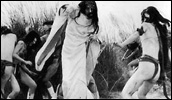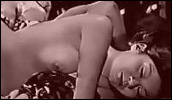The Horror of Malformed Men
- Year
- 1969
- Original title
- Edogawa Rampo Zenshu Kyofu Kikei Ningen
- Japanese title
- 江戸川乱歩全集 恐怖奇形人間
- Alternative title
- Horror of a Deformed Man
- Horror of a Malformed Man
- Director
- Cast
- Running time
- 99 minutes
- Published
- 28 January 2005



by Tom Mes
Unique minds make unique films. Case in point: Teruo Ishii. Ishii amassed a filmography of over 80 titles between his debut with Ringu no Oja: Eiko no Sekai in 1957 and his death in 2005. Though he is predominantly known for his series of gleefully sleazy exposés on Edo-era torture practices that began with The Joys of Torture, his back catalogue contains more than a few films whose outrageousness is of quite another kind.
Of these, The Horror of Malformed Men stands out as one of the most singular cinematic experiences not just in Ishii's history, but in all of Japan's. Combining a spectrum of influences that stretches from Rampo to butoh, it taps into the country's post-nuclear trauma so audaciously that people reportedly fled theaters in disgust upon its release and that it has been consistently barred from appearing on video or DVD since. Yet, it is beautiful, haunting and oneiric; it is perhaps the closest one can come to a dreamlike experience without closing one's eyes.
Recounting the plot of The Horror of Malformed Men is futile. Despite being narrative in nature, it ascribes to no apparent logic. Ishii and his co-screenwriter Masahiro Kakefuda have strung together elements from a variety of Edogawa Rampo works, including The Human Chair (Ningen Isu), The Stroller in the Attic (Yaneura no Sanposha), The Twins (Soseiji), The Strange Tale of Panorama Island (Panorama-to Kitan) and The Ogre of the Secluded Island (Koto no Oni), and fashioned them around an amnesiac young doctor's search for his missing father. The father, a Dr. Moreau-esque deranged scientist, lives on an island where he has created a private dominion populated by horrible hybrids of man and beast, the by-products of a wish-turned-obsession to cure his disfigured wife.
Symbolic of The Horror of Malformed Men's refusal to surrender to plausibility or narrative verisimilitude is the central figure of butoh founder Tatsumi Hijikata as the unhinged doctor, scurrying across the rocky island coast in a crablike fashion, Ishii's jump cuts making his choreographed movements seem even more erratic. Dressed in a skintight silver dress, his mad eyes peering through a shroud of long black hair, Hijikata delivers his dialogue in a procession of gutteral intonations. Spastic at one moment, brooding at another, his performance is the polar opposite of star Teruo Yoshida, who wisely tones down his acting to the point of seeming to sleepwalk, a very appropriate decision given the film's overall ambience.
In a more literal reading this film could doubtlessly be called messy and illogical, but what it displays is the kind of unordered, primal illogicality of a dream. The Horror of Malformed Men is a dream; one that would be a nightmare if it weren't so grotesquely beautiful.